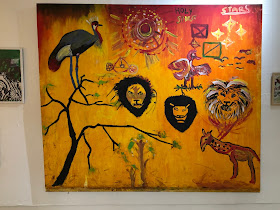By
Margaretta wa Gacheru (posted 26 February 2020)
Ever since
the International Trade Centre found out about Goodie Odhiambo and her work in
product development with women groups around Kenya, they went looking for her.
“ITC wanted
to link me up with women artisans in Dadaab Refugee Camp,” says Goodie who
helps lots of artisans to upgrade their products so they are in line with what
she calls ‘market trends’.
This is what
Goodie has been doing with Dadaab women groups for the last two years, the
fruits of which are on display at Village Market’s Lower Food Court from Friday,
February 28th through Sunday, March 1st.
The display
by the ‘Nyota Farsamo Dadaab Collective’ is called the ‘Dadaab Connections: an
interior design showcase from Dadaab” and will run all three days from 10am to 7pm.
“What are being
showcased are beautiful baskets, mats, cushions, furniture, lampshades and tie dye
textiles,” says Goodie, who adds that several of the women have come with their
goods from Daadab and will be at Village Market to talk about their work with
Nyota Farsamo.
At the time
that Goodie was contacted by ITC, she had already been working with a number of
women groups, many of whom she helped to organize.
“I
especially like working with women groups who are already making things but
need support, both in product development and by giving them a platform where
they can showcase and sell their things,” adds the owner of Goodie’s African
Interiors and Gifts in Westlands.
ITC wanted Goodie
to assist Dadaab women through a program called the Refugee Employment Skills
Initiative. They needed someone having the same skills set as Goodie has. A
graphic designer by training and women entrepreneur by practice, Goodie had a
special appeal to ITC in that she is known for assisting women groups develop
community-based structures everywhere from Turkana to Kitui.
“I work with
anywhere from 80 to 100 individual artisans. But among them, at least 20 of
them represent their women group,” says Goodie.
She started
her business in 2009. In the case of the Dadaab Refugee women, she found that many
of them had traditional skills in things like weaving and hand-plaiting mats
and baskets as well as in tie-dying fabrics. But they needed to improve their
designs and learn more about market trends and tastes. These were the issues
that Goodie was asked to address.
But before
she could get to work on tackling those topics, she had to work on getting the
women organized into groups.
“I have
often helped women form working collectives,” she says. In the case of the
Dadaab women, she helped them first to form five groups who then gave themselves
the name ‘Nyota Farsamo Dadaab Collective’ and chose Fatuma Athar Haji to be
their chairperson.
One of the
things that Goodie does for the women is to add value to their products. For
instance, the women send her beautiful tie-dye fabrics and she makes fluffy pillows
out of them. “I also consult with them on the shapes and colors of everything,
be it the tie and dye or the baskets,” says Goodie who also works with them on
quality control.
Showing me a
‘before and after’ set of baskets, she explains that the ‘before’ basket was
loose and floppy at the top, but after getting advice from Goodie, the women not
only to make a new style of basketry but the basket also now had a tighter
weave at the top so it has a more functional and attractive appeal.
Another way
that she has helped the women to develop a new product to sell is by adapting
the tie-dye to different formats. “We sell the tie-dye material in assorted
colors and designs, but now we also transform the material into lampshades that
have a market both in the Westlands shop and online at www.africaninteriors.co.ke.
But Goodie doesn’t
only assist women. For instance, one of the artisans that she works with is a
carpenter. “I had bought some beautiful fabric from Mali and wanted to do
something useful with it so I gave it to him. He then used the material to make
me a comfortable chair which is upholstered with my Mali material,” she says.
Goodie was
tempted to take that chair home and keep it, but instead, it’s in her shop for
all to see and for her to sale.





















